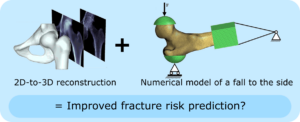2D-to-3D biofidelic computational models can better assess fracture risk in osteoporotic men
One in two women and one in four men over 50 years will suffer an osteoporotic fracture in their lifetime, leading to increased mortality and decreased life quality. To be able to reduce the number of fractures, we need to identify the subjects who are at high risk before they fracture. However, current clinical methodologies fail to identify 30-50% of those who will fracture.
We know that over 90% of osteoporotic fracture of the hip results from a fall, but that less than 5% of all falls result in a fracture. None of this information is currently used to predict fracture risk. This project aims at building 3D subject-specific numerical models that predict whether a fall to the side would result in a hip fracture or not. This is performed by combining advanced 3D-based subject-specific numerical models with a method to reconstruct 3D hips from their 2D clinical x-ray images (DXAs).
The ability to predict fracture outcomes will be validated against a cohort of 1000 men living in Skåne, for which DXA images were collected at baseline, and then they were followed for fractures for over 5 years. One strength is that the computational modelling is compatible with current clinical care while being based on advanced engineering analyses of the mechanical behaviour of human hips. A successful project would be a milestone towards bridging the gap between engineering and medicine to provide improved healthcare.

